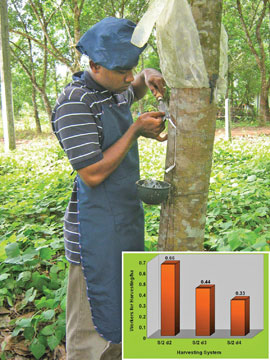|
Another wage hike granted:
Is LIH the answer to efficient rubber tapping?
by Dr. Lakshman RODRIGO
Wage hikes are inevitable. As we all know, wages in the plantation
sector have very recently increased by about 27%; from Rs. 405 to Rs.
515 per day. With EPF and ETF contributions, the total comes to Rs. 572
per day. This has an effect on other terminal benefits such as gratuity.
Continuous increase in cost of living associated with the inflation
drives people to demand for high wages.
 Further, due to the improvement in science and technology and
striking advertisements, people are constantly attracted to new
luxuries; another reason to demand high wages. In the past, plantation
workers were considered to be a underprivileged category. Further, due to the improvement in science and technology and
striking advertisements, people are constantly attracted to new
luxuries; another reason to demand high wages. In the past, plantation
workers were considered to be a underprivileged category.
This is not so anymore and it should not have been so; being involved
in key economic activities, their contribution to the nation building is
second to none.
They are covered and protected by strong trade unions supported by
parliamentarians. This has strengthened their bargaining power.
Recognising the needs and importance of this sector, the government has
taken steps to provide them educational and health facilities. As a way
of improving social dignity, official designations given to plantation
workers have recently been changed with a special gazette notification.
Nonetheless, some have already moved to other sectors for greener
pastures.
Whilst meeting worker needs, plantations should maintain financial
viability, under any circumstances. Undoubtedly, current prices for raw
rubber can cope with recent wage increase in rubber plantations.
Competitiveness
Although there is no speculation on market collapse, we need to be
proactive to sustain rubber plantations for the future. Competitiveness
would be the best approach for sustainability. Particularly in human
resource management, worker - use efficiency and worker
satisfaction/motivation are key issues to be tackled. Cost of production
(COP) generally declines with increase in worker use efficiency.
Nevertheless, it is not always the case in the competitive market since
workers are to be motivated with improved wage structures.
Unlike in the past, managerial staff in most Regional Plantation
Companies (RPCs) has been reduced to the bare minimum with added
facilities, being given to them. In rubber plantations, latex harvesting
is quite labour intensive utilising over 60% of the worker force. In
COP, its share is well over 1/3. Therefore, it is high time to revise
harvesting policies in rubber estates for improved worker use
efficiency. Latex is usually harvested from rubber trees by tapping the
tree trunk with a half spiral cut (i.e. half of the circumference) once
in two days.
This is called S/2 d2 harvesting (S/2 stands for half spiral cut and
d2 for once in two days). Each harvester is given about 300 trees per
day hence 600 trees in a two day cycle. This means an area having 600
trees requires a harvester every day. Rubber is planted at a density of
515 per hectare, however it diminishes to some extent with time.
Expecting an average of about 400 trees in tapping per hectare, worker
requirement for harvesting of mature rubber is about 0.6 per hectare per
day.
This is just second to tea while coconut needs only about 0.2 per
hectare per day.
Less labour
All attempts made so far to mechanise rubber harvesting has been
futile and there is no sign of it being a reality even in the near
future. Waiting for latex harvesting machines would not be a wise
decision.
Is it necessary to tap the rubber tree so often? Is there a way to
get latex with less labour? Alternative methods in latex harvesting: Low
Intensity Harvesting (LIH) systems are found to be the most appropriate
means to increase worker - use efficiency in latex harvesting.
 What does LIH mean? When compared to traditional S/2 d2, either
harvesting frequency or tapping cut length or both are reduced in LIHs.
Reduction in the harvesting frequency is made by extending the time gap
between two consecutive harvesting over two days and commonly named as
Low Frequency Harvesting (LFH). What does LIH mean? When compared to traditional S/2 d2, either
harvesting frequency or tapping cut length or both are reduced in LIHs.
Reduction in the harvesting frequency is made by extending the time gap
between two consecutive harvesting over two days and commonly named as
Low Frequency Harvesting (LFH).
Instead of half spiral, attempts have been made to reduce the cut
length to quarter spiral or even less. As everyone would expect,
reduction in harvesting frequency and cut length has a negative impact
on latex yield.
To compensate the yield loss associated with this reduced intensity,
yield stimulants are to be applied in a judicious manner. Ethylene is
the ultimate stimulant which enhances latex production in the
laticiferous system in the rubber tree bark.
Obviously, outside application of ethylene gas is not simple and so,
ethephon is generally used as a liquidised paste in different
formulations to facilitate a slow release of ethylene inside the bark.
It is available in the market under different trade names (e.g. Ethrel,
Ethephon Plus).
In the past, latex yield stimulants were used with the intention of
increasing the yields.
This has been a wrong decision and today, it remains as a short-term
approach perhaps suitable for the rubber fields on the verge of
uprooting. In the long run, the potential yield of a rubber tree cannot
be exceeded in harvesting. Perhaps, one may have planted a rubber clone
having a high genetic potential for high yields. However, the way it has
been looked after determines the ultimate yield potential.
Studies have shown that over harvesting with stimulants results in
yield decline in subsequent years and leads to physiological disorders
such as Tapping Panel Dryness (TPD) where latex synthesis in the bark
ceases.
Therefore, ethephon is used in LIH only to obtain the potential
yield. Only to compensate yield loss due to reduction in harvesting
frequency or cut the length or both.
On the safe side, as a rule, we could consider yield given by
time-honoured S/2 d2 as the potential. To overcome time related
discrepancies associated with the harvesting frequency, the average
yield per tree per year (YPT) or yield per hectare per year (YPH) could
be taken for comparison.
How does LIH increase worker - use efficiency and is it the only
advantage? Apparently, we could expect a four-fold benefit from LIH;
firstly worker use efficiency. With the increased time gap between two
harvesting, each harvester can be allocated a greater number of tapping
blocks resulting in reduced harvester requirement.
To be continued...
|

